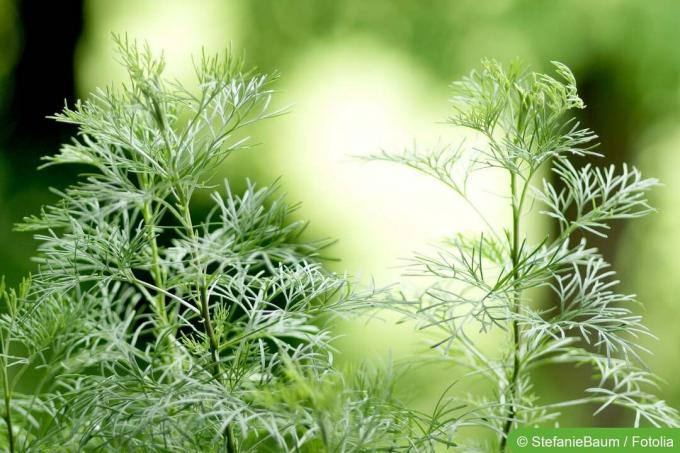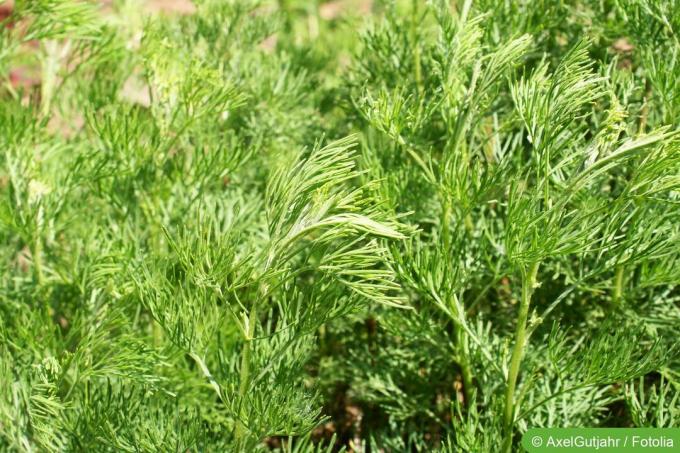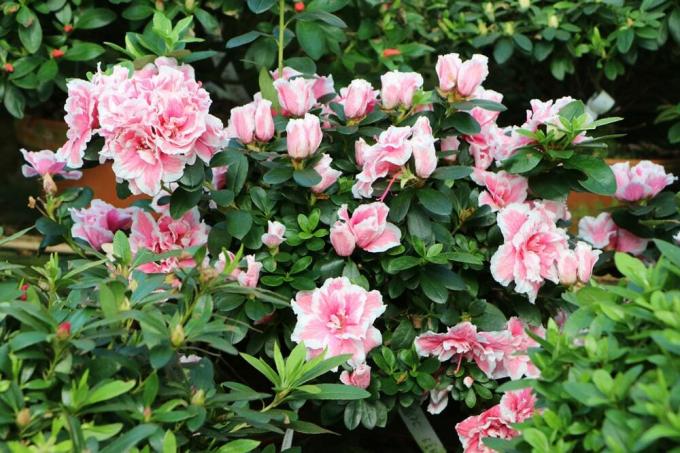

Table of contents
- Location
- substrate & soil
- watering & fertilizing
- Cut
- multiply
- Plant
- Cultivation in the bucket
- hibernate
- Care mistakes, diseases or pests
- Southernwood as a tea
- Conclusion
- particularities
- care and cut
Southernwood is a herbal plant that is also becoming increasingly popular in the kitchen. As a relative of mugwort, tarragon or wormwood, it gives off a scent of lemon, camphor or cola, depending on the type of culture. As a result, it was already very popular as a room fragrance in ancient times. Originally native to America, Asia and southern Europe, it is always found in the local latitudes more followers, especially because the perennial Artemisia abrotanum can also find a place on a windowsill.
Location
Since the southernwood plant originally comes from warm places of origin, such as the Mediterranean countries, it needs a location in full sun in order to thrive. This can be cultivated directly in the garden bed or in a tub on a terrace, a south-facing balcony or on the windowsill on a south-facing window. The Artemisia abrotanum is also popular as a ground cover in the garden bed or on a slight slope. It is also very suitable as a small hedge, for example as a border to a vegetable patch.
Tip:
With its intense smell, it repels pests and this can also benefit the plants in the kitchen garden.
substrate & soil
The soil for the southernwood plant is, at best, slightly calcareous and permeable. Therefore, when planting, mix in some sand, stones or gravel for permeability. Otherwise, the following should be considered when choosing the floor:
- Absolutely avoid waterlogging
- Mix in zeolite or pumice
- Constant wetness can damage the plant, especially in winter
watering & fertilizing
Southernwood plant doesn't need much. Water only moderately, for Artemisia abrotanum planted outdoors the falling rain is completely sufficient. Only plants cultivated in tubs and during a long drought in summer have to be watered. But even in these cases it is better to water too little than too much, because the southernwood plant tolerates prolonged drought rather than too much moisture. There is also not much need to be fertilized:
- use compost or horn shavings for fertilizer in spring
- mix them in the ground
- upgrade a lime-poor soil with garden lime from the trade
Cut
The plants should be cut back to the woody main shoot in spring because they have a great need to grow. They then sprout vigorously again. If the southernwood plants as ground cover or hedge have become too strong and dense for you, you can Cut back the Artemisia abrotanum close to the ground in autumn, so that a new form can be created later in spring arises.
multiply
Southernwood can be propagated in three different ways: cuttings, sowing or root division. Since in the local climate usually no seeds are formed on plants cultivated in the garden, these have to be bought in stores. Propagation is easy in all three variants:
- for cuttings, the ideal time is spring
- cut new long shoot with tip
- Keep the soil moist in the pot and put the bag over it
- a little patience is needed for root formation
- Use commercially available seeds for sowing
- these are light germs, so don't stick them deep into the ground, just sprinkle them over it
- due to pests such as ants attracting seeds in pots
- prick out when small leaves form
- Plant at the location when small, strong southernwood plants have formed
- for root division, the entire plant must be taken out of the ground
- remove the soil from the root altogether
- Using a sharp knife, divide the roots and thus also the Artemisia abrotanum in the middle
- with sufficient distance to each other and to other plants
Tip:
Since propagation with cuttings usually only succeeds in half of all cases, seeds or the simple method of division should be used.
Plant

When planting southernwood, it is important to ensure that several plants are not placed too close together. A distance of about 30 cm all around is ideal here. Because the southernwood plant likes to spread and therefore needs enough space on all sides. Proceed as follows when planting in the garden bed:
- choose a sunny location and make sure there is enough space on all sides
- dig hole
- Mix the excavated soil with compost and horn shavings
- Insert the plant and add soil again, pressing down lightly
- water enough, in the next few weeks do not add water at all
Cultivation in the bucket
If the southernwood is cultivated in a pot, the procedure should be as follows:
- Lay drainage over the drain hole
- Stack up gravel, stones or shards of pottery and place plant fleece over them
- Use garden or bucket soil
- enrich with garden lime if necessary
- Insert the plant and fill up the soil all around and press down lightly
- water lightly, do not overwater
- After a while, pour off excess water from the saucer
- repotting is not really necessary
- if you like, you can change the soil every two to three years
- whoever uses calcareous water can also save themselves changing the soil
- a larger pot does not have to be chosen here
hibernate
The southernwood plant is hardy and therefore does not need extra protection. It is usually enough if it is cut down to the ground in autumn. Then brushwood all around on the ground and the remaining plants lie. This protects the Artemisia abrotanum from too much moisture in winter, which does not do you any good in connection with the cold.
Care mistakes, diseases or pests
Due to the flow of essential oils, southernwood has few pests that could get in your way. On the contrary, planted between or around a kitchen garden, its smell drives away annoying flies and parasites that could damage the cultivated vegetables. Nevertheless, aphids can even afflict her. These attach themselves to the shoots and leaves of Artemisia abrotanum. If the shoot tips of the plant are deformed and the leaves are curled up and yellowed, action must be taken. A water-curd soap solution that the hobby gardener simply sprays onto the plants has proven effective here.
Tip:
If you cultivate your southernwood plant in a bucket and place it at the corners of the terrace, you will have fewer flies at the table in summer.
Southernwood as a tea
As mentioned at the beginning, you can prepare a tea from the leaves of southernwood. The fresh shoots are harvested from June to flowering. The leaves can be used fresh or dried to make tea. For the tea, a branch is brewed with half a liter of water, which then has to steep for ten minutes. In the case of dried southernwood leaves, half a liter of water is brewed over a tablespoon of herb and left to steep for five minutes.
The tea serves as a tonic and is also used in natural medicine to treat gastrointestinal complaints and problems with digestion. Furthermore, southernwood is said to have a wonderful ability to strengthen the immune system and is also a perfect cold remedy. The tea is also said to give new strength, which is particularly beneficial for ill and elderly people. For use in the kitchen, the fresh southernwood leaves are cut off and can then be dried. You can also freeze the fresh leaves.
Conclusion
Southernwood is a herbal plant for those who like to keep things simple. Since it is very easy to care for, does not need a lot of water and fertilizer and makes few demands on the location, it is also a wonderful scented plant for the beginner. Cultivated in tubs on the patio, it also has a pleasant aroma that keeps flies away. It can also be used as a tea or as a spice in the kitchen.
particularities
- Southernwood is also known as lemon herb and has the botanical name "Artemisia abrotanum".
- This plant is also called cola bush, because if you gently stroke the fine leaves, it gives off a scent that is reminiscent of the taste of cola.
- Southernwood originally comes from southern Europe. Today they are found not only in Central and Southern Europe, but also in North America and the Near East.
- The perennial, perennial plant is used as a crop. How to process their aromatic leaves z. B. in floral water, mothballs and potpourris.
- A tea can also be prepared from the leaves, which is used as a tonic.
- Southernwood is also used as a bath additive or poultice. In this way, major problems can be dealt with.
- Southernwood is used in the kitchen as a herb for salads, sauces, fish and quark dishes.
Tip:
Due to the very intense smell, southernwood should always be used very sparingly.
- In addition to these uses, southernwood is also perfect for edging beds.
- The herb of the southernwood is also a perfect mosquito repellent, because if you rub yourself with the herb, mosquitoes stay away.
- Southernwood grows between 70 and 100 cm tall and is an upright, bushy plant.
- The typical flowering period is from July to September, when the plants show inconspicuous to yellowish flowers.
care and cut
- Southernwood thrives best in a sunny location and prefers well-drained, moderately dry to fresh soil.
- This should be slightly alkaline to alkaline. Southernwood does not tolerate waterlogging and must be protected from waterlogging, especially in the cooler seasons.
- The individual plants are planted at a distance of 40 to 50 cm from each other.
- The perennial plant can easily remain in the same place for three to four years.
- Otherwise, southernwood is a very undemanding plant, because you usually don't have to water it additionally, since normal rain is sufficient.
- In hot summers, with long dry periods, however, you have to help with watering a little.
- Southernwood can be propagated by cuttings, although there are numerous nurseries that offer this plant in spring.
- Southernwood is a perennial plant that is hardy. This allows them to hibernate easily.
Cut
The shoots are only shortened in the spring, which can be done without any problems up to the woody main shoot. This allows the plant to sprout again quickly and strongly. If you make a cut to beautify the growth habit, you can also use southernwood to create a tall herb hedge that can even act as a privacy screen.
 garden editorial
garden editorial I write about everything that interests me in my garden.
Learn more about shrubs and woody plants

17 flowering hardy plants May to October
Many plants only show their full splendor for a short time. But there are also types and varieties with a particularly long flowering period from May to October, sometimes even longer. We present 17 flowering hardy plants.

25 hardy and evergreen ornamental trees
Ornamental trees are among the most popular plants in the garden. They have a decorative effect and set special accents in the green oasis. If you are tired of the gray of the cold season, you can plant trees that are hardy and evergreen.

Is barberry poisonous? | What is to be considered?
With their dense growth, numerous thorns and evergreen foliage, barberries are one of the most popular types of plants for a hedge in the garden. Before cultivating the sour thorn family (Berberidaceae), many ask themselves whether the plant is poisonous.

Azalea location: 6 important criteria
Azaleas are a flowering addition to the garden or living room, as long as they are in the right location. In the following guide to azaleas, we will tell you what to look out for.

How fast does a rhododendron grow? | Information about growth
How fast a rhododendron grows depends on various factors, including the variety, location and care. Growth can be accelerated under optimal conditions, while deficiencies lead to stunted growth.

Butterfly bush: the ideal location | Buddleia
The uncomplicated, easy-care and robust butterfly bush is suitable in the garden for borders, a flowering hedge or as a solitaire. Dwarf summer lilacs are ideal for pot culture. Buddleia bloom from June to October and are a magnet for many butterflies.



